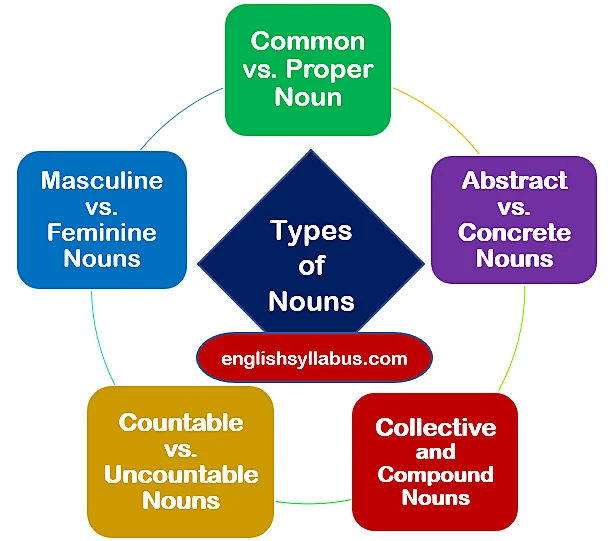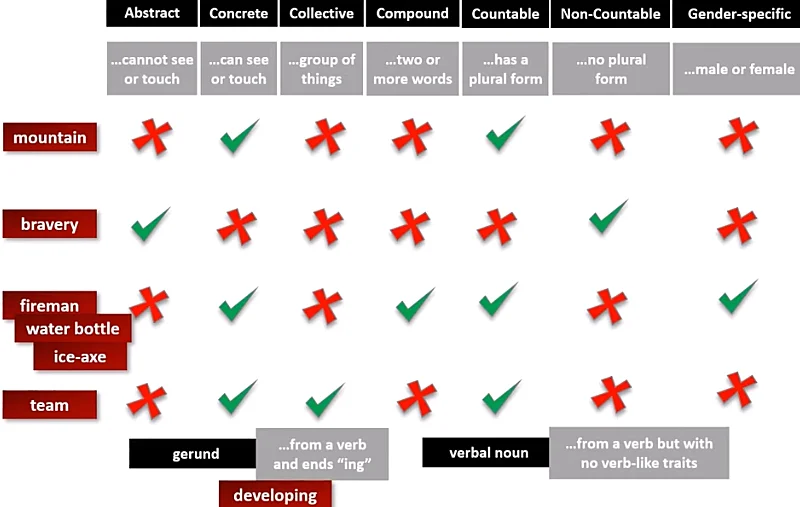Definition
A noun is a word used to name a person, place, thing, or idea. It is one of the basic parts of speech in English grammar and is used to identify, label, or refer to people, places, things, or ideas in a sentence. Nouns can be singular or plural and can be modified by articles, adjectives, and other modifiers. They can also be used in a variety of grammatical functions, including as subjects, objects, possessives, complements, or appositives, and more given below.
- Subject
- Direct Object
- Indirect Object
- Subject Complement
- Object Complement
- Direct Address
- Indirect Address
- Object of Preposition
- Possessive Noun
- Appositive
- Gerund
- Participle
- Infinitive
- Expletive
- Noun Phrase
- Absolute Phrase
How Nouns Function in English Grammar
Time needed: 20 minutes
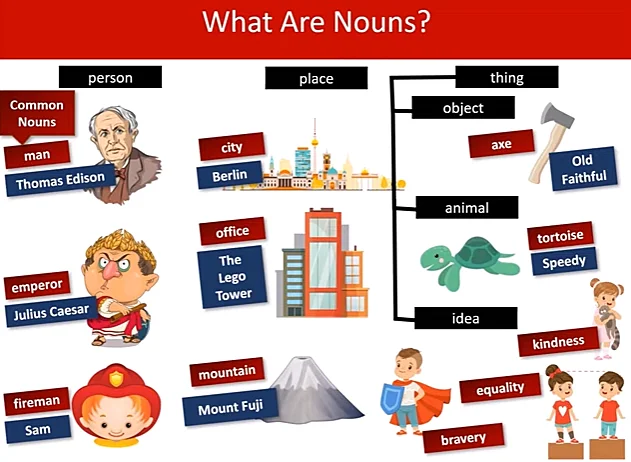
Learn Types of Nouns with the Best Examples
Common vs Proper Nouns
Common nouns are general names for people, places, things, or ideas while proper nouns are specific names for people, places, things, or ideas.
Functions of Common and Proper nouns
- Identification: Proper nouns are used to identify specific people, places, things, or ideas, while common nouns refer to general groups or categories.
- Capitalization: Proper nouns are always capitalized, while commons are not.
- Specificity: Proper nouns convey specific information about a person, place, thing, or idea, while common nouns provide more general information.
- Memorability: Proper nouns are often more memorable than common ones as they are unique and specific.
- Clarity: Proper nouns help to clarify meaning by indicating exactly what is being referred to, while common nouns can be vague and ambiguous.
Table of Common vs Proper Nouns Examples
| Common Nouns | Proper Nouns |
|---|---|
| cat | Garfield, the orange tabby cat |
| city | Paris, the capital of France |
| car | Toyota Camry, a popular sedan |
| book | “To Kill a Mockingbird“, a Pulitzer Prize-winning novel |
| country | Brazil, the largest country in South America |
| movie | The Godfather, a classic crime film |
| school | Harvard University, a prestigious Ivy League school |
| planet | Mars, the fourth planet from the sun |
| musician | John |
| fruit | Apple, a crisp and juicy fruit |
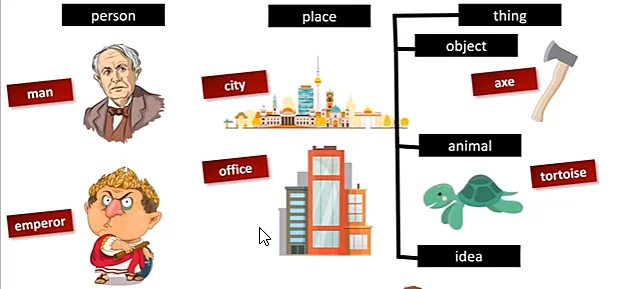
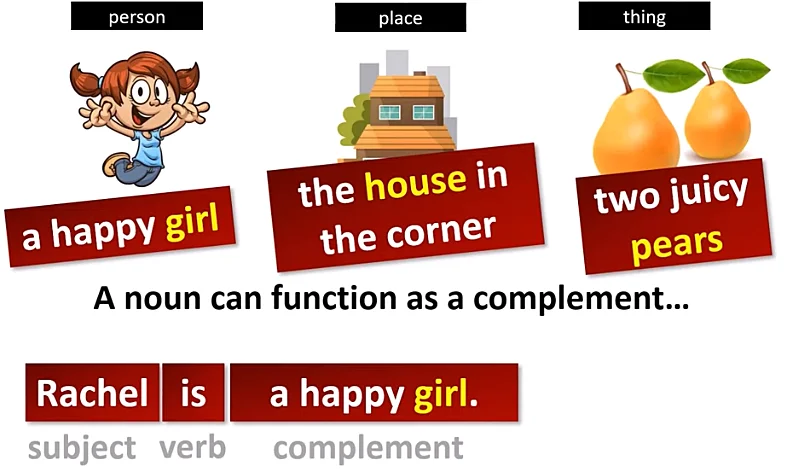
Abstract vs Concrete Nouns
Abstract Nouns: Abstract nouns are names for intangible concepts, feelings, or qualities that cannot be perceived through the five senses.
Examples of abstract nouns: are love, courage, sadness, beauty, and intelligence.
Functions of abstract nouns:
- Conceptualization: Abstract nouns allow us to conceptualize intangible ideas or qualities, making them easier to discuss and understand.
- Emotion: Abstract nouns are often used to express emotions or feelings that are difficult to describe using concrete language.
- Generalization: Abstract nouns allow us to generalize or categorize things into broader groups or concepts.
- Comparison: Abstract nouns can be used to compare or contrast different ideas, qualities, or emotions.
- Analysis: Abstract nouns can be used to analyze or evaluate complex ideas or systems.
Concrete Nouns: Concrete nouns are names for tangible objects or things that can be perceived through the five senses.
Examples of concrete nouns: are tree, book, car, beach, and pizza.
Functions of concrete nouns:
- Identification: Concrete nouns allow us to identify specific objects or things.
- Description: Concrete nouns provide a means of describing objects or things in detail.
- Clarity: Concrete nouns help to clarify meaning by indicating exactly what is being referred to.
- Visualization: Concrete nouns help us to visualize and understand the world around us.
- Memorability: Concrete nouns are often more memorable than abstract ones, as they are concrete and tangible.
Table of Abstract vs Concrete Nouns with Examples
| Abstract Nouns | Examples | Concrete Nouns | Examples |
|---|---|---|---|
| Love | “I have a special love for you.” | Car | “I drove the car.” |
| Courage | “She showed great courage.” | Tree | “I climbed the tree.” |
| Sadness | “He felt overwhelming sadness.” | Book | “I read the book.” |
| Beauty | “The beauty of the sunset was breathtaking.” | Beach | “I went to the beach.” |
| Intelligence | “Her intelligence impressed me.” | Phone | “I answered the phone.” |
| Honesty | “Honesty is the best policy.” | Chair | “I sat in the chair.” |
| Freedom | “We fought for our freedom.” | Dog | “I petted the dog.” |
| Justice | “Justice must be served.” | Mountain | “I climbed the mountain.” |
| Knowledge | “The knowledge he imparted was invaluable.” | Computer | “I used the computer.” |
| Strength | “She showed great strength in adversity.” | Rock | “I threw the rock.” |
Collective vs Compound Nouns
Collective nouns are singular nouns that refer to a group of people, animals, or things. Examples include family, team, jury, flock, herd, crowd, committee, band, choir, and staff.
Functions of Collective Nouns
- As subjects of sentences: The committee is meeting tomorrow.
- As objects of sentences: The crowd cheered as the team scored a goal.
- As possessives: The flock’s migration patterns have been studied extensively.
- As object complements: The boss named Maria as the head of the team.
- As indirect objects: The teacher gave the class a surprise quiz.
Compound nouns are made up of two or more separate words that function as a single unit. The words in a compound noun can be connected by a hyphen or simply written together as one word. Examples include snowflake, toothbrush, honeymoon, waterfall, eyeglasses, sunflower, snowman, baseball, headphones, and motorcycle. Compound nouns can be made up of two nouns, a noun and an adjective, or a verb and a noun.
Functions of Compound Nouns
- As subjects of sentences: The snowflake melted on my nose.
- As objects of sentences: I need to buy a new toothbrush.
- As possessives: The honeymoon’s romantic atmosphere was perfect.
- As modifiers in noun phrases: The waterfall hike was breathtaking.
- As part of idiomatic expressions: She’s wearing rose-colored glasses.
Table of Collective vs Compound Nouns with Examples
| Collective Nouns | Examples | Compound Nouns | Examples |
|---|---|---|---|
| Family | “The Smith family is going on vacation.” | Snowflake | “I caught a snowflake on my tongue.” |
| Team | “The team won the championship.” | Toothbrush | “I need to buy a new toothbrush.” |
| Jury | “The jury reached a verdict.” | Honeymoon | “They went on a romantic honeymoon.” |
| Flock | “The flock of birds flew south for winter.” | Waterfall | “The waterfall was breathtaking.” |
| Herd | “The herd of cows grazed in the field.” | Eyeglasses | “I lost my eyeglasses.” |
| Crowd | “The crowd cheered for the performer.” | Sunflower | “The sunflower was in full bloom.” |
| Committee | “The committee made a decision.” | Snowman | “They built a snowman in the front yard.” |
| Band | “The band played their hit song.” | Baseball | “He hit a home run with the baseball.” |
| Choir | “The choir sang beautifully.” | Headphones | “I listen to music with my headphones.” |
| Staff | “The staff is working hard today.” | Motorcycle | “He rode his motorcycle to work.” |
Countable vs Uncountable Nouns
Countable nouns refer to objects or concepts that can be counted as individual units. They have both singular and plural forms and can be preceded by a numeral, like “one,” “two,” or “three.” Examples of countable nouns include “dog,” “book,” “chair,” “pen,” “person,” and “apple.”
Characteristics of Countable Nouns
- They have singular and plural forms.
- They can be counted as individual units.
- They can be preceded by a numeral, such as “one,” “two,” or “three.”
- They can be used with quantifiers like “many,” “few,” or “several.”
- They can be modified by words like “each,” “every,” or “all.”
Uncountable nouns, on the other hand, refer to objects or concepts that cannot be counted as individual units. They do not have a plural form and cannot be preceded by a numeral. Examples of uncountable nouns include “water,” “milk,” “air,” “sugar,” “information,” and “advice.” These nouns are usually measured in terms of quantity, such as “a glass of water,” “a carton of milk,” or “a piece of advice.”
Characteristics of Uncountable Nouns
- They do not have a plural form.
- They cannot be counted as individual units.
- They cannot be preceded by a numeral.
- They are measured in terms of quantity, such as “a cup of coffee” or “a piece of advice.”
- They can be modified by words like “some,” “a lot of,” or “not much.”
Table of Countable vs Uncountable Nouns with Examples
| Countable Nouns | Examples | Uncountable Nouns | Examples |
|---|---|---|---|
| book | I have two books on my desk. | water | I drink ten glass of water in a day. |
| chair | There are four chairs at the dining table. | rice | I need to buy some rice for dinner. |
| dog | She has a dog named Max. | milk | He doesn’t like milk in his coffee. |
| cup | Can you please pour me a glass of water? | sugar | Can you pass me the sugar, please? |
| car | We drove the car to the beach. | salt | I don’t put salt on rice. |
| computer | She works on her computer all day. | cheese | I want to buy some cheese for the party. |
| student | The students are studying for their exams. | bread | Can you pick up a loaf of bread on your way home? |
| house | We just bought a new house in the suburbs. | oil | I need to buy some oil to cook dinner. |
| pen | Can I borrow a pen to take notes? | flour | She is baking a cake and needs some flour. |
| phone | He answered the phone after the third ring. | coffee | He loves to drink coffee in the morning. |
Masculine vs Feminine Nouns
In English grammar, masculine and feminine nouns refer to nouns that indicate male and female gender, respectively. Generally, masculine nouns are used to describe the male gender, while feminine nouns are used to describe the female gender. However, many nouns do not have a clear gender association and are considered neutral.
For example, “king” and “prince” are masculine nouns, while “queen” and “princess” are feminine nouns. “Horse” and “bull” are typically masculine nouns, while “mare” and “cow” are typically feminine nouns. It’s important to note that not all nouns have a gender, and that gender is not always determined by the sex of the noun’s referent.
Characteristics of Masculine and Feminine Nouns in English Grammar
- Gender-specific: Masculine and Feminine nouns are gender-specific and denote male and female living beings or objects respectively.
- Pronouns: Pronouns used to refer to masculine nouns are “he/him/his” while the pronouns used for feminine nouns are “she/her/hers”.
- Articles: Masculine nouns usually take the article “a” or “an”, while feminine nouns usually take the article “the”.
- Suffixes: Masculine and Feminine nouns can be identified by their suffixes. For example, words ending in “-or” or “-er” are often masculine, while those ending in “-ess” or “-ine” are often feminine. However, this is not always the case and there are exceptions.
Table of Masculine vs Feminine Nouns
examples:
| Masculine Nouns | Feminine Nouns |
|---|---|
| actor | actress |
| bachelor | spinster |
| boy | girl |
| brother | sister |
| bull | cow |
| cock | hen |
| colt | filly |
| count | countess |
| duke | duchess |
| emperor | empress |
| father | mother |
| fox | vixen |
| gentleman | lady |
| groom | bride |
| king | queen |
| lion | lioness |
| nephew | niece |
| prince | princess |
| ram | ewe |
| son | daughter |
Nouns FAQs
Answer: A noun is a word that refers to a person, place, thing, or idea. Examples include dog, Paris, love, and teacher.
Answer: Nouns can function as the subject, direct object, indirect object, object complement, appositive, subject complement, in direct address, possessive, gerunds, infinitives, participles, expletives, subjective complements, prepositional objects, objects of infinitives, and absolute phrases.
Answer: A common noun refers to a general, non-specific person, place, or thing, and are not capitalized unless they start a sentence. Examples include dog, city, car, and happiness. while a proper noun refers to a specific, named person, place, or thing and are always capitalized. Examples include John, Eiffel Tower, Coca-Cola, and Shakespeare.
Answer: Abstract nouns are nouns that name intangible things, such as emotions, concepts, or ideas. Examples include love, freedom, and justice.
Answer: Concrete nouns are nouns that name physical, tangible things that can be perceived by the five senses. Examples include table, cat, and ocean.
Answer: Countable nouns are nouns that can be counted, such as books or chairs, while uncountable nouns are nouns that cannot be counted, such as water or air.
Answer: Collective nouns are nouns that refer to groups of people or things. Examples include family, team, and herd.
Answer: Compound nouns are nouns made up of two or more words that function as a single unit. Examples include basketball, brainstorm, and airport.
Answer: A gerund is a verb that acts as a noun, ending in -ing. Examples include running, swimming, and cooking.
Answer: An infinitive is a verb that acts as a noun, adjective, or adverb, usually beginning with “to”. Examples include to eat, to swim, and to sleep.
Answer: A possessive noun is a noun that shows ownership or possession. Examples include John’s car, the cat’s toys, and the company’s profits.
Answer: Appositives are nouns or noun phrases that rename or explain another noun in a sentence. Examples include my friend, the doctor, and the capital of France.
Gerunds are verbs that are used as nouns. They end in “-ing” and can function as the subject or object of a sentence. Examples include “swimming”, “reading”, and “writing”.
Yes, nouns can function as adjectives when they are used to modify another noun. For example, in the phrase “car engine”, “car” is a noun acting as an adjective to describe the type of engine.
Yes, proper nouns can become common nouns when they are used generically. For example, “Kleenex” is a proper noun, but it is often used to refer to any brand of tissue paper, which makes it a common noun.
